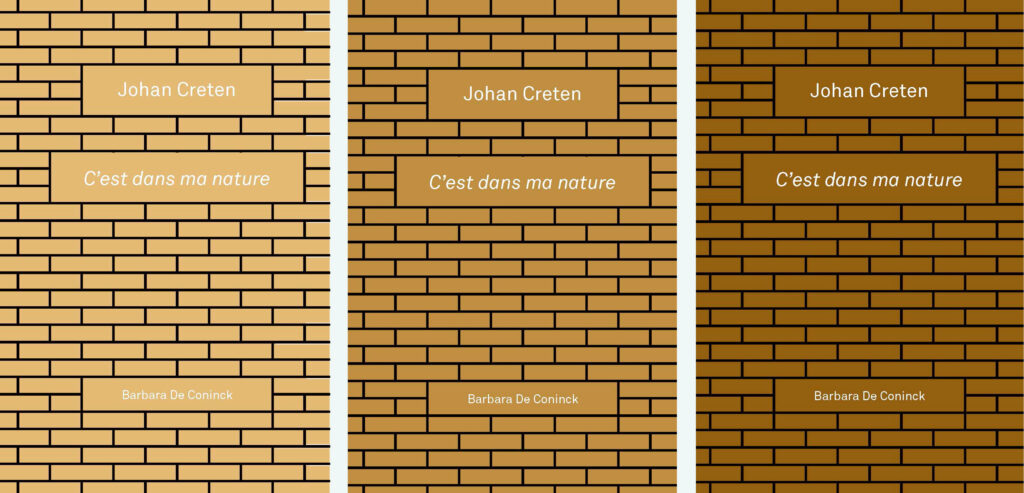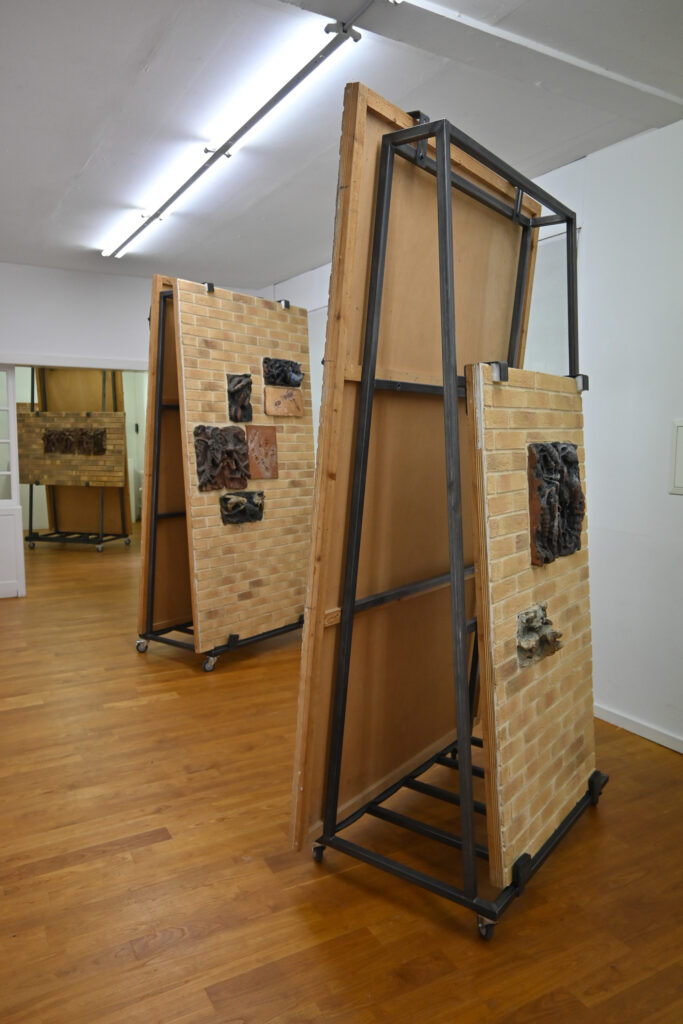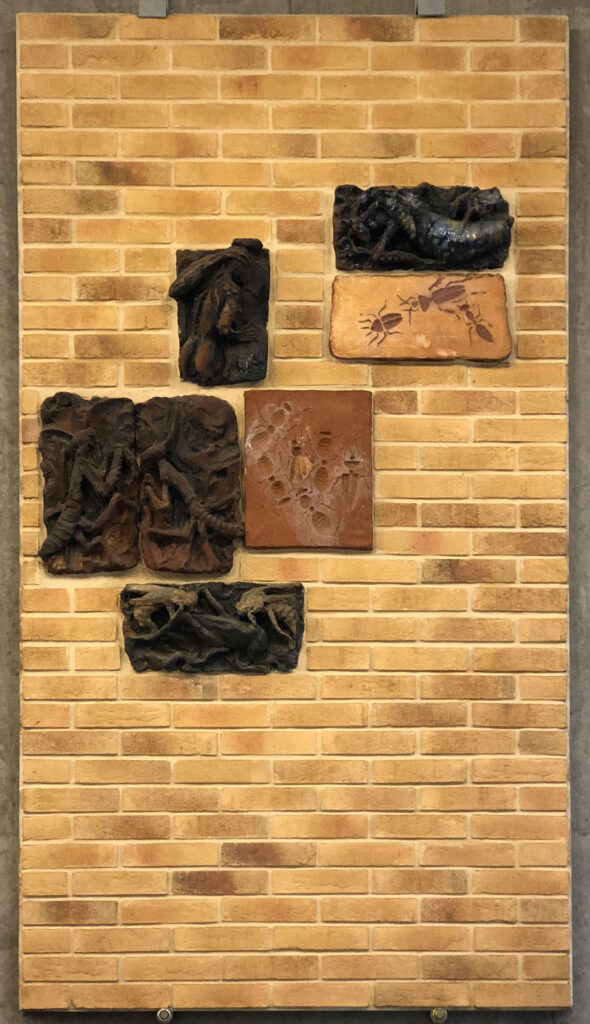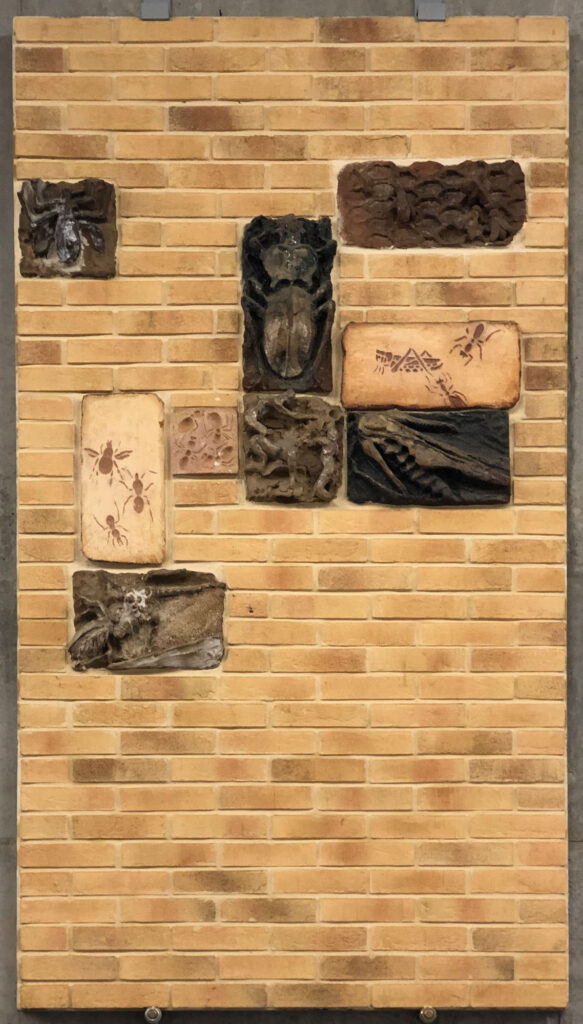Johan Creten | C'est dans ma nature
C’est dans ma nature comprises seven vertical and three horizontal brick-patterned panels of varying dimensions, without any discernible sense of order. A total of sixty-one figurative ceramic tablets are scattered across the panels. Yet each contains only a handful of these sculpted ‘tiles’. In other words, we are faced with a patchwork rather than a frieze. Without exception, the bas-reliefs in glazed stoneware are small in size. Here, against the background of imitation brick (fausses briquettes), the narrative unfolds. […]
C’est dans ma nature is an allegory of a world that is tilting. It depicts the pourriture noble [noble rot] of disrupted animal and human societies. The sixty-one expressive, almost naturalistic bas-reliefs function as metaphors and show the flip side of what was once an Eden: the socially perfect organisation of biotic communities.
[Scroll down for more text by Barbara De Coninck]
NEDERLANDS
C’est dans ma nature is een project met een bijzondere geschiedenis [2000 – 2021]. Barbara De Coninck, die voor de begeleidende publicatie de tekst schreef, verwoordt het als volgt: ‘een intrigerend, spannend en ontroerend sleutelwerk in het oeuvre van Johan Creten. Een werk dat getuigt van verbeelding, experiment, engagement, ook een werk van een secrete schoonheid’.

FRANÇAIS
C’est dans ma nature est un projet avec une histoire unique [2000 – 2021]. Barbara De Coninck, qui a écrit le texte pour la publication d’accompagnement, le formule ainsi : ‘une oeuvre clé intrigante, passionnante et émouvante dans l’oeuvre de Johan Creten. Une oeuvre qui témoigne d’imagination, d’expérimentation, d’engagement, aussi une oeuvre d’une beauté secrète’.

ENGLISH
C’est dans ma nature comprises seven vertical and three horizontal brick-patterned panels of varying dimensions, without any discernible sense of order. A total of sixty-one figurative ceramic tablets are scattered across the panels. Yet each contains only a handful of these sculpted ‘tiles’. In other words, we are faced with a patchwork rather than a frieze. Without exception, the bas-reliefs in glazed stoneware are small in size. Here, against the background of imitation brick (fausses briquettes), the narrative unfolds.
At first glance, C’est dans ma nature seems dour: rigid, wilful, stubborn, recalcitrant and unruly. It emits a grim and dark energy. Massive and compact, it overwhelms the viewer. What is it about?
Johan Creten explicitly avoids all forms of abstraction in his motifs. We stand face to face, alternately, with a motley collection of creatures (insects) and human figures, either solitary people or small groups, active and in motion, never rigid. There seems to be no hierarchy between animals and humans.
The bas-reliefs are treated sculpturally and are very pronounced, although Creten has used the intaglio technique in some five instances. The colour scheme is sombre, from plaster-like white and sandy beige to terracotta red, dark brown and even black. Only a handful of reliefs in Sèvres blue shimmer in the light.
Three quarters of the sculpted bas-reliefs are teeming with bees, wasps, flies and other Hymenoptera, ants, butterflies, dragonflies, mantises, moths, woodlice, grasshoppers, ground beetles, ticks, bugs and stag beetles. An indeterminate filthy beast has Aztec features. A scorpion lasciviously shows off its bulging contours. A dead grasshopper is devoured by necrophagous insects. An ant is drenched by a layer of blue glaze. Might the woodlice be imprints of stolen larvae?
In general, this garden of nature is visually unappealing: C’est dans ma nature is certainly no Alice in Wonderland. The creatures appear to have been struck by a hammer. They seem doomed to regression and decay. Bees lie there lifeless, flattened or in unnatural positions, trapped beneath a thick paste.
C’est dans ma nature does not emit the sweet fragrance of honey. Only a fragment remains of the honeycomb’s alveolar structure. This is not a bee parliament, but a battlefield: an inverted Genesis, a ferocious bestiary, a hecatomb.
“It snows and we have died now,
Softly falling homeward,
It snows and we have died now,
It snows between the hives.”
(Martinus Nijhoff)
A minority of bas-reliefs depict human figures – anonymous beings, solitary or in pairs, sometimes in threes but in groups of up to seven. Nowhere is there a recognisable face. Amongst the crowd, one woman stands out, running away from an indefinable place of doom. A profound silence emanates from each and every scene. A couple seems to be sinking into lava, another figure caresses his partner’s head. In a Baroque bas-relief, the head of one of the three characters disappears into the panel, like an angel in a cloud. Two individuals rush to escape in a gesture of mutual support, a defeated man crouches on the ground. Naked and diminutive, with its soft skin of clay, this shadow also submits to his fate. One silhouette is missing its head and foot. Another figure appears handcuffed. Are those two figures pushing a third person off a rock – the victim seems to be a child? Is there really a strangulation taking place further on? There is so much to see. We don’t know where to look first. The fellatio – including the voyeur? Or the three figures reaching out to one another? The group of seven with open palms, huddling around a central figure? Those who kneel, stand up, float, fall? Those who indifferently step over others, those who trample – like a miniature version of the Heysel disaster?
In its ornamentation of distorted human and animal life, C’est dans ma nature recalls the apocalyptic representations by eleventh-century sculptors on Roman tympanums and capitals. The artist’s lexicon evokes memories of Dante Alighieri’s shadows in The Divine Comedy (Inferno) (1472), Auguste Rodin’s wandering souls on the Gates of Hell (1888), or the refugees in Honoré Daumier’s Emigrants (or Fugitives) (1855-1856). Johan Creten’s monumental artwork is an archive of conflicting images – snippets of figuration, fragments of Old and New Testament stories, tropes that evoke myths and epics.
C’est dans ma nature is an allegory of a world that is tilting. It depicts the pourriture noble [noble rot] of disrupted animal and human societies. The sixty-one expressive, almost naturalistic bas-reliefs function as metaphors and show the flip side of what was once an Eden: the socially perfect organisation of biotic communities.
[Barbara De Coninck, 2021]
We gladly present two new editions in bronze:
C’est dans ma nature, 2021, patinated bronze lost wax casting, titled, signed, inscribed “Aulnay-sous-Bois, naar ‘Les Rairies’, naar Mechelen, naar …”, eagle stamp, foundry mark Art Casting, edition of 7 plus 2 e.a., 33 x 110 x 8 cm, price on request

La Rencontre, 2021, patinated bronze lost wax casting, titled, signed, eagle stamp, foundry mark Art Casting, edition of 7 plus 2 e.a., 35 x 23 x 8 cm, price on request

| NEDERLANDS C’est dans ma nature bestaat uit zeven verticale en drie horizontale panelen met baksteenpatroon van variabele afmetingen en in blijkbaar willekeurige volgorde. Over de panelen verspreiden zich keramische figuratieve tabletten, 61 in totaal. Elk van de tien panelen bevat slechts een handvol van deze gesculpteerde ‘tegels’. We staan met andere woorden voor een patchwork eerder dan een fries . De bas-reliëfs van geëmailleerd steengoed zijn zonder uitzondering klein van formaat. Hier, tegen de achtergrond van imitatie baksteen (fausses briquettes), ontspint zich het narratief. Bij een eerste aanblik oogt C’est dans ma nature stug: stijf, bokkig, koppig, dwars, weerspannig en weerbarstig. Het verspreidt een grimmige en duistere energie. Massief en compact overrompelt het de kijker. Waar gaat dit over? In zijn motieven gaat Johan Creten uitdrukkelijk elke abstractie uit de weg. We staan afwisselend oog in oog met een bonte verzameling van dieren (insecten) en menselijke figuren, deze laatsten in kleine groepjes of solitair, actief en in beweging, nergens verstard. Tussen dieren en mensen lijkt geen hiërarchie te spelen. De bas-reliëfs zijn overwegend in de hoogte uitgewerkt en hun opbouw is sculpturaal, al gebruikt Creten tot vijf keer toe de intaglio-techniek . De kleurvoering is somber, van gipsachtig wit en zanderig beige over terracotta-rood tot donkerbruin en zelfs zwart. Enkel een handvol reliëfs in Sèvres-blauw schitteren in het licht. Op drie kwart van de gesculpteerde bas-reliëfs krioelen bijen, wespen, vliegen en andere vliesvleugeligen, mieren, dagvlinders, libellen, mantissen, motten, pissebedden, sprinkhanen, loopkevers, teken, torren en vliegende herten. Een onbestemd viezebeest heeft Azteekse trekken. Een schorpioen laat wellustig zijn vette vormen zien. Necrofage insecten vreten een dode sprinkhaan aan. Een mier wordt gesausd met een jas van blauw email. Zijn de pissebedden eventueel imprints van gestolen larven? Het ziet er over het algemeen niet goed uit in de tuin van het natuurlijke leven: C’est dans ma nature is beslist geen Alice in Wonderland. De dieren staan erbij alsof de kop van een hamer hen een slag heeft toegediend. Ze lijken veroordeeld tot regressie en verval. Bijen liggen er zieltogend bij, platgedrukt of in onnatuurlijke posities, verkleefd onder een dikke brij. C’est dans ma nature verspreidt niet de zoete geur van honing. Van de alveolaire structuur van de honingraat rest slechts een flard. Dit is geen bijenparlement, wel een slagveld: een omgekeerde Genesis, een woest bestiarium, een hecatombe. “Het sneeuwt, wij zijn gestorven, wij dwarrelen naar beneden. Het sneeuwt, wij zijn gestorven, het sneeuwt tusschen de korven .” (Martinus Nijhoff) Een minderheid aan bas-reliëfs beeldt menselijke figuren uit – anonieme gestalten, solitair of in paar, soms met zijn drieën en tot wel zeven in hun soort. Nergens een herkenbaar gezicht. In de schare valt één vrouw op, wegrennend uit een onbestemd onheilsoord. Van alle taferelen gaat een grote stilte uit. Nu eens lijkt een stel in lava weg te zinken, dan weer strijkt een figuur strelend zijn partner over het hoofd. In een barok uitgewerkt bas-reliëf verdwijnt, als een engel in een wolk, het hoofd van een van de drie personages in het paneel. Twee individuen slaan spoorslags op de vlucht terwijl ze elkaar ondersteunen; een verslagene hurkt tegen de grond. Naakt en nietig, met zijn zachte huid van klei ondergaat ook deze schim zijn lot. Van één silhouet ontbreekt zowel het hoofd als de voet. Een andere gedaante verschijnt geboeid ten tonele. Duwen daar twee figuren een derde gestalte van een rotsblok af – het slachtoffer lijkt warempel nog een kind? Vindt verderop werkelijk ook nog een wurging plaats? Er is zoveel te zien. We weten niet waar eerst te kijken. De fellatio – inclusief de voyeur? De drie figuren die elkaar de hand reiken? De groep van zeven met open handpalmen, drommend rond een centrale persoon? Zij die knielen, opstaan, zweven, vallen? Zij die gevoelloos over een ander heen lopen, zij die vertrappelen – als in een Heizel-drama in miniatuur? In zijn ornamentiek van verwrongen mensen- en dierenleven herinnert C’est dans ma nature aan de apocalyptische voorstellingen van elfde-eeuwse beeldhouwers op Romaanse timpanen en kapitelen. Het lexicon van Johan Creten roept herinneringen op aan de schimmen van Dante Alighieri in zijn Divina Commedia (Inferno) (1472), aan Auguste Rodins dolende zielen op de Porte de l’Enfer (1888), aan de vluchtelingen in Les Emigrants (1855-1856) van Honoré Daumier. Zijn monumentale kunstwerk is een archief van conflictueuze beelden – snippers van figuratie, flarden van oud- en nieuwtestamentische verhalen, tropen die mythes en epen evoceren. C’est dans ma nature is een allegorie van een slagzij makende wereld. Het werk verbeeldt de pourriture noble van ontwrichte dierlijke en menselijke samenlevingen. De 63 expressieve, bijna naturalistische bas-reliëfs functioneren als metaforen en tonen de achterkant van wat eens een Eden was: de maatschappelijk perfecte organisatie van levensgemeenschappen. [fragment uit catalogustekst van Barbara De Coninck] |

Publication
C’est dans ma nature, 2021, hard cover, 18 x 11 cm
in three separate versions: Dutch, French & English, each 500 copies, text Barbara De Coninck
Available as a complete set for € 45
Download perstekst hieronder
Open: vrijdag, zaterdag & zondag 14 – 18 uur, geen reservatie nodig
Of eveneens te bezoeken na afspraak via +32 478 811 441 of +32 475 477 478
Here is the team that transported the ten panels of C’est dans ma nature from Thomas More hogeschool to galerie Transit, Zandpoortvest 10, 2800 Mechelen
















